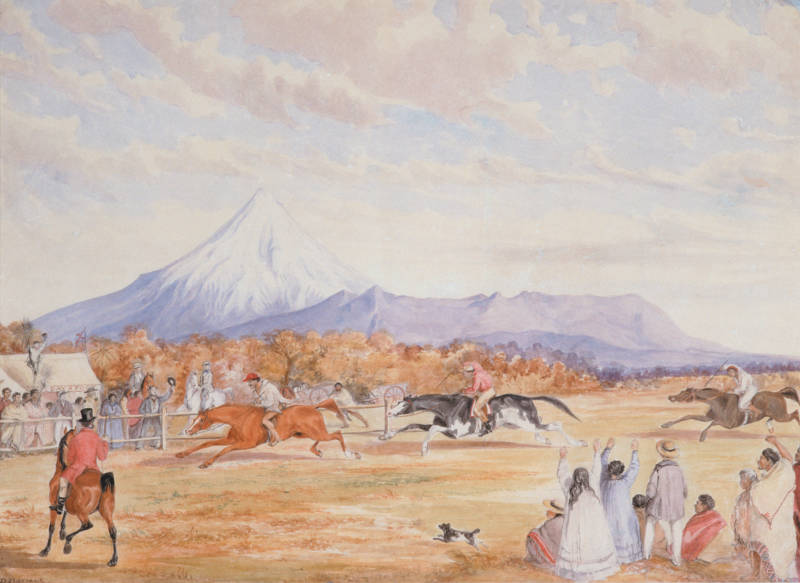BARRAUD, Charles Decimus;
Māori Race Meeting at the Hui
1878
Watercolour on paper
771 x 888mm

The following two texts were written for Te Huringa/Turning Points and reflect the curatorial approach taken for that exhibition.
Peter Shaw
This watercolour records a unique sporting occasion and is one of very few paintings of the time that depict social interaction of any kind between Māori and Pākehā. In many paintings of the period, Māori are represented as passive bystanders observing Europeans at work.
The Waitara hui of 20 to 30 June 1878 was attended by the Prime Minister, Sir George Grey, and all the chiefs previously at war with the government, including Wiremu Kīngi, Wiremu Tako, Makoare Te Taonui, Karaitiana Takamoana, and Tītokowaru. The hui involved a negotiated peace settlement and as such was greeted with optimism by settlers and Māori alike.
The painting shows the finish of the titular race, at which both Māori and Pākehā spectators are cheering enthusiastically. The first two riders are tattooed; in what was probably intended as a comic touch, the winner is shown wearing no trousers. In the foreground, the clerk of the course, on horseback, is correctly attired in hunting pink frock coat and top hat. To the right of the refreshment tent are two well-dressed European gentlemen on horseback. One of these is Sir George Grey, who, according to the Taranaki Herald of 29 June 1878, attended the hui and was invited to take part in the festivities. The tent bears the names of Day & Foot; a James Day is listed in New Plymouth business directories and newspaper advertisements as proprietor of the White Hart Family Hotel, in Devon Street. The figure in the lower right depicted applauding the winners with raised hand is the Waikato chief Rewi Maniapoto, who is recognisable from the cloak he habitually wore and in which he was photographed in 1875.
Special trains ran from Ngāmotu New Plymouth to Waitara during the hui and the government paid for buildings to house the visiting tribes. On June 29, the final day of the hui, a public holiday was declared and the assembled company was involved in feasting and sports activities of the kind depicted here.
Jo Diamond
While Barraud provides us with a rare record of a social event that mainly involved Māori people, one cannot help wondering what records Māori people themselves kept and whether they still survive. Would a pictorial record such as those of the Ringatū Church’s prophet Te Kooti Arikirangi Te Tūruki and his following, as discussed by Roger Neich is his book Painted Histories, show a similar scene? They may have seen this event in a completely different light from Barraud. Though such a thing is not known, a richer impression of this event may have been passed down through descendants of those Māori people who attended the race meeting, and, like Barraud’s watercolour painting, some of this record may be pictorial.
The inequity that exists between the publication of European impressions of such events, and the absence of published Māori records of it, is a telling indictment of social inequality; one of many examples that exist around the world in colonised countries. Whai mana, mana renewed for Māori people, would give those people in this painting, and others like them, an opportunity to provide their own narratives about this notable event, as well as many others still unacknowledged in the official history of this country.
Exhibition History
Te Huringa/Turning Points: Pākehā Colonisation and Māori Empowerment, Sarjeant Gallery Te Whare o Rehua, Whanganui, 8 April to 16 July 2006 (toured)
Provenance
2002–
Fletcher Trust Collection, purchased December 2002
–2002
Unknown

